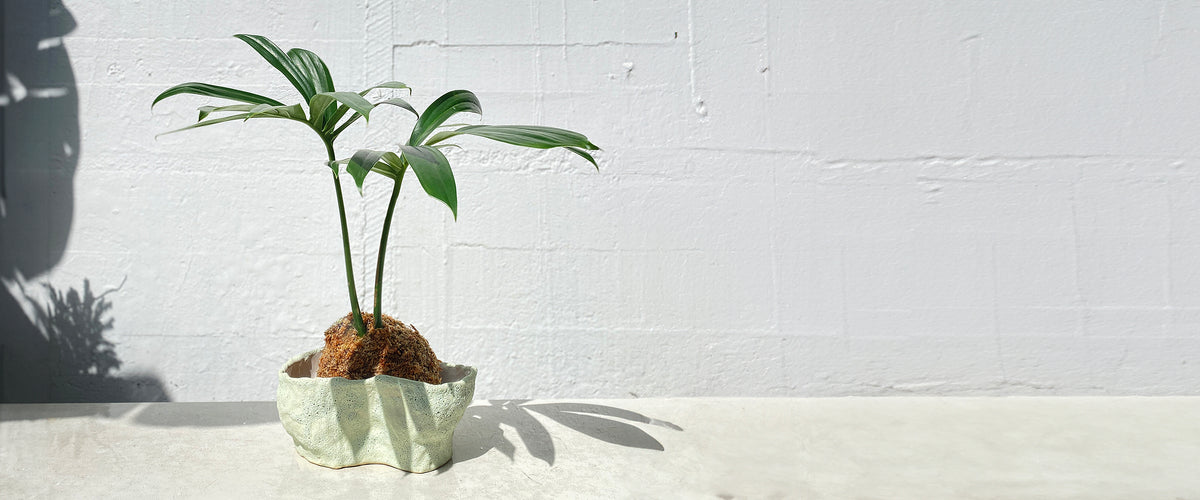Hoya
 Botanical Name: Hoya
Botanical Name: Hoya
Common Name: Wax plant
Plant Family: Apocynaceae
About the fascinating Hoya…
The Hoya genus contains over 500 species of flowering vines and creepers, native to tropical regions of Asia and Australia. The leaves tend to be hard and waxy to the touch, earning this genus the common names ‘wax plant’ or wax flower’. Hoya are easily identified by their umbellate flower clusters, a collection of tiny rounded star shaped blooms in a perfect umbrella formation. Most Hoya sold as houseplants are cultivars of H. carnosa (such as hindu rope, purpureo-fusca, Krimson queen), and have a strong climbing habit supported by adventitious roots.
Temperature/ Sun
Hoya like bright, indirect light, though can handle much lower light levels. However, flowering may not occur without bright light. The optimal temperature range for Hoya is 16-29℃, making it possible for Hoya to be grown in a sheltered position outside if desired, in warm temperate climates.
Watering
Water frequently enough in spring to summer that the soil is kept lightly moist. Less so in winter- let the top few inches dry out between waterings. Misting can be useful in the warmer months to increase humidity, or use a pebble tray or keep in a high humidity area such as a bathroom.
Growing medium
Hoya are naturally epiphytic, so use a well aerated growing medium. Potting mix cut with perlite or pumice is suitable, or try your Hoya in Leca. Purportedly, keeping hoya somewhat rootbound in a small pot will hasten flowering.
Flowering
Spurs (peduncles) grow from the axils of the leaves and stem, and though similar in appearance to stems, will eventually produce flowers. Never cut the spur, even after flowering has finished, as new flowers grow from the same tip.
Flowers are arguably the Hoya’s best feature. In houseplant varieties, clusters of tiny little chubby stars with a smaller five pointed structure on top, reflex backwards to create a tight umbrella shape, or sometimes a ball. Flowers are usually sweetly scented and may produce nectar. Colours range from white-pink, red-dark purple, yellow-orange and green. The umbels tend to hang downwards, and are usually best viewed from below.
If you are patiently waiting for your hoya to flower, bear in mind they don’t bloom until mature - 5-7 years. Ensure the plant is getting enough light and nutrients, and resist the urge to move it around. They don’t handle being relocated well, especially when flowering.
Fertilisation
Fertilise monthly from spring to autumn with a liquid feed, giving your Hoya a break over winter. Look at the NPK ratio on the back of a plant food bottle. It is recommended that a higher nitrogen feed be used most of the time (2:1:2, or 3:1:2). During flowering, and for the two months prior, switch to a high phosphorus feed (e.g. 5:10:3) to promote profuse blooming.
Propagation
Hoya are easily propagated through air-layering or stem cuttings. Take cuttings that are around 10 cm long with one or two leaves, dip in rooting hormone and plant into a well-aerated mix or start in water. Be careful not to cut the flower spur!
Diseases
Mealybug, scale: Remove insects with a baby wipe or cotton bud. Spray plant down with bugtrol or neem oil
Aphids: Take plant outside and hose aphids off. Spray down with bugtrol or neem oil
Root rot, leaf drop, blackened leaves, stem dieback: Often caused by overwatering and/or poor draining soil.
Wilting or dieback of foliage: Under or over watering, can also be caused by excessive fertiliser leading to the build up of salts in the soil.
Maintenance
There is no need to prune Hoya, as it produces new growth from the ends of stems. Definitely don’t prune the flower spur. If your Hoya is taking over your house, or you want to create a bushier plant, you may trim stems to the desired length, though go easy- Hoya’s do not like hard pruning. The semi-soft stems of the previous year’s growth can be easily propagated from.
Toxicity
Hoya are considered non-toxic, and safe for children and pets. However, the waxy leaves are not easily digestible and may cause stomach upset.
On the other hand, Hoya are superior at removing common household volatile organic compounds from the air. A study from the University of Georgia tested how well 28 common houseplants removed five VOC’s (benzene, TCE, toluene, octane, and α-pinene) from the air. Hoya carnosa was ranked in the top five performing houseplants, classified as having ‘superior removal efficiency’.
References:
https://en.wikipedia.org/wiki/Hoya_carnosa
https://en.wikipedia.org/wiki/Hoya_(plant)
https://www.gardeningknowhow.com/ornamental/vines/hoya-wax-plant/hoya-plant-feeding.htm
https://www.gardeningknowhow.com/ornamental/vines/hoya-wax-plant/getting-wax-plant-to-bloom.htm
https://www.gardeningknowhow.com/ornamental/vines/hoya-wax-plant/growing-hoya-wax-vines.htm
https://homegarden.cahnr.uconn.edu/factsheets/houseplants-safe-and-toxic-varieties/
https://www.rhs.org.uk/plants/hoya/growing-guide
Yang, D. S., Pennisi, S. V., Son, K. C., & Kays, S. J. (2009). Screening indoor plants for volatile organic pollutant removal efficiency. HortScience, 44(5), 1377-1381.
